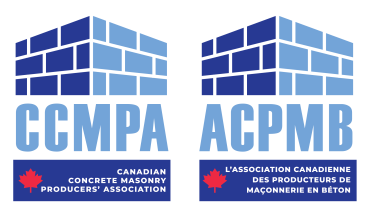
Are you in the know?
I'm Andrea McChesney, the Executive Director of the CCMPA, and we want to ensure you and your team have all the access to the latest and greatest in CCMPA activities and industry buzz.
Sincerely, Andrea & your CCMPA team.

RE: Article, July 17, 2009, Wellington Advertiser, “Township Approves Demolition Permit After Termites Hit Elora Home”
The Canadian masonry industry is concerned about the misinformation conveyed by Building Inspector Bob Foster to the readers of the Wellington Advertiser. In particular, Mr. Foster allegedly stated, to the effect, “…one problem with the house was its construction used blocks instead of solid concrete walls… that leaves a building particularly vulnerable to termites, because they can enter through very small openings”.
Readers may be left with the understanding that concrete block masonry foundations are not suitable and are inadequate to resist termites. Indeed, nothing could be farther from the truth.
Termites feed only on materials which contain cellulose, most notably wood in house construction, and cannot feed on concrete block masonry. In fact, concrete block masonry is the construction system of choice for areas in the southern United States, such as Florida, where termite control is essential.
Readers also may be left with the opinion that poured concrete foundations resist the entry of termites better than concrete block masonry foundations. Subterranean termites nest in the ground, and their entry into a home must be gained through a sheltered path of width greater than about 1/32” (1 mm), such as a crack or hole. There are many strategies that are used to control termite infestation. Some are particular to the design and construction of the foundation, to its junctions between other elements such as the wood frame it supports, and to intended penetrations through the foundation. Other strategies are site-related, or include on-going maintenance, or chemical treatments. All things being equal, the implication of Mr. Foster’s statement is that concrete block masonry foundations offer more frequent and wider cracks than do poured concrete foundations, apparently because they are not of “solid concrete”. Once again, this is not factual, and fully misleading.
The properties of poured concrete and concrete block masonry are remarkably alike because the materials in each system are essentially cement-based concretes. Proper foundation design is also similar, with both systems requiring comparable strength and deflection limits, and the same level of resistance to water penetration. Concrete block masonry foundations are not fully “solid”, with some resulting advantages. Standard design and construction practices ensure that the block foundation is capped with solid masonry and that mortar joints between the concrete block units are fully solid, compacted, and tooled to prevent unintended openings in and through the finished construction. Quality construction practices for both foundation systems minimize unintended openings by sealing junctions and sealing around penetrations. These design and construction practices are intended to reduce the likelihood of entry routes, and to provide a dry environment unfavourable for termites. These are the same strategies necessarily used in the construction of both systems to otherwise resist water penetration and air leakage. Although most foundation cracks are small and harmless, if one were to choose a single characteristic which most heavily influences the likelihood of foundation cracking, it is “drying shrinkage”. For both poured concrete and concrete block masonry, drying shrinkage occurs after the foundation is constructed as water evaporates from the materials and as the cement cures (gains strength). The potential for drying shrinkage is greater for a poured concrete foundation because the concrete must be “wet” and flowable at the time of placement, whereas concrete block units are pre-manufactured, pre-cured and “pre-shrunk” before laying. The drying shrinkage of poured concrete is about twice that of concrete block masonry. By strict comparison, the potential for drying shrinkage cracking in poured concrete is greater than that for concrete block masonry.
Finally, readers may be left with the belief that simply constructing a termite-resistant foundation is all that is needed to ensure that termites do not enter interior space over time. Other measures may be required, including for example, preparing the site prior to construction to eliminate sources of food for the termites, providing proper backfill and drainage to offer a dry environment, identifying and sealing points of entry other than through the foundation, maintaining minimum clearances from soil to wood framing, on-going maintenance, and chemical treatments.
With full certainty, our experience tells us that there are much more compelling and influential causes other than use of a concrete block masonry foundation which have led to the demolition of this reportedly termite-infested structure. These either have not been appropriately identified or revealed by Mr. Foster, or they are unstated in the news article.
For additional information about concrete block masonry foundations, please visit the website of the National Concrete Masonry Association at www.ncma.org or the Canadian Concrete Masonry Producers Association at ccmpa.ca.
Gary R. Sturgeon, B.Eng., MSc., P.Eng.
Technical Services Engineer
Canadian Concrete Masonry Producers Association